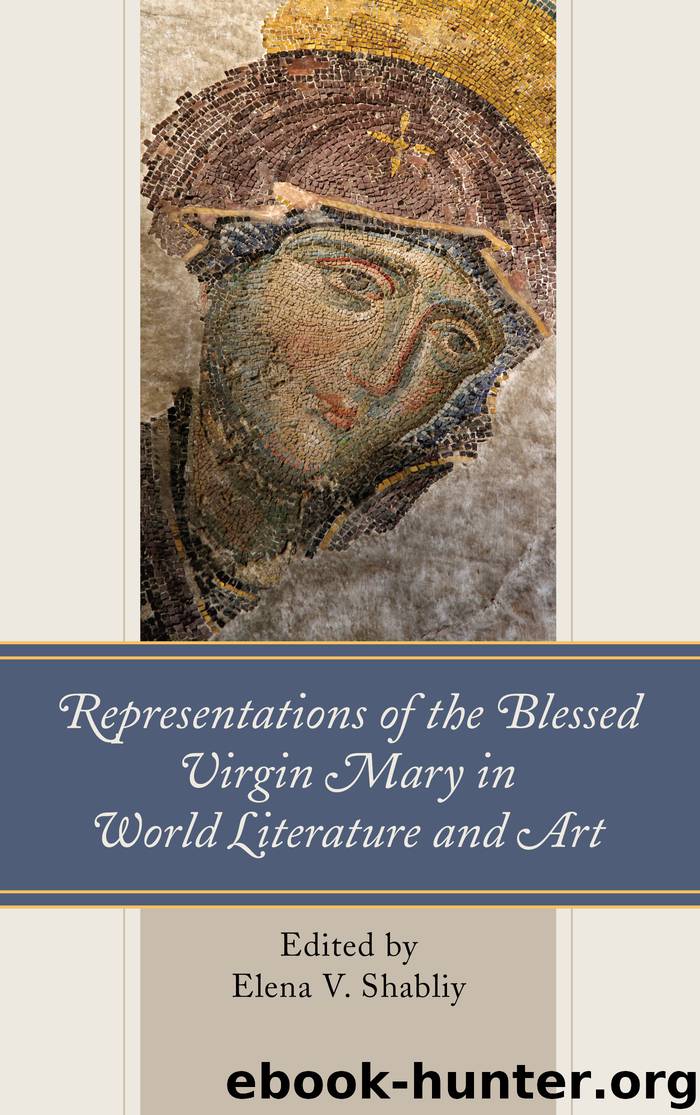Representations of the Blessed Virgin Mary in World Literature and Art by Elena V. Shabliy

Author:Elena V. Shabliy
Language: eng
Format: epub
Tags: undefined
Publisher: Lexington Books, a division of Rowman & Littlefield Publishers, Inc.
Published: 2012-03-12T16:00:00+00:00
That is all. Many of the accepted beliefs about Mary are based on tradition rather than scripture. There are no irrefutable biblical foundations for the attitudes concerning Mary’s eternal virginity, her own Immaculate Conception, or her corporeal Assumption, yet these beliefs have flourished. In fact, looking at the textual evidence within the Bible, most of the honors attributed to Mary seem exaggerated at best, completely unfounded at worst.[16] However, many of these ideas seem to have been firmly established already within the first generation of the Church. Since no relevant contrary stories or refutations exist, some critics and historians have argued that the stance concerning the Virgin Mary was already somehow incontestable.[17] Whatever the case, the official opinion of the Church from the very beginning seems to have been one of love and veneration. As John McHugh observes, Mary’s special rank within the Church “is implied by the text of the Magnificat, where Luke says that ‘from his present time’ all generations will call her blessed. Could Luke have written that phrase if, at the time when he was writing (A.D. 70–80), his own generation had not already begun to call her blessed?”[18] The Bible offers nothing of Mary’s life before the Annunciation, but by the second half of the second century, an apocryphal work describing her conception and birth appeared. The Gospel of James [Protoevangelium of James] was extremely influential in the West and “gave rise, directly or indirectly, to all other legendary treatments of the topic” of Mary’s life.[19] The narrative deals with Mary’s miraculous birth to her long-childless parents, Joachim and Anna, Mary’s upbringing in the temple, her consignment into the care of Joseph, the Annunciation, the birth of Christ, the visit of the Magi, and the Massacre of the Innocents. The text is important in its testimony to the development of nonbiblical Marian beliefs even at this early date.
The first references to Mary by the Christian Fathers begin in the second century and can be seen as the foundations for nearly all the ideas concerning Mary that appear later in the Latin hymns. Stephen Shoemaker notes that even these first biographies intersect with the Gospel of James:
Although Justin would first explore the theme of Mary as the New Eve around the middle of the second century, only with the near simultaneous appearance of the so-called Protoevangelium of James do we find a significant break in the silence surrounding the life of Christ’s mother. This early Christian apocryphon, it would seem, initiated the process of writing the Virgin’s biography, beginning with the events of her childhood and her own miraculous conception. In the centuries that followed, other apocrypha would take up different moments from her life, including especially its dramatic conclusion, and collectively these narratives formed the basic building blocks for the medieval Lives of the Virgin.[20]
Download
This site does not store any files on its server. We only index and link to content provided by other sites. Please contact the content providers to delete copyright contents if any and email us, we'll remove relevant links or contents immediately.
Resisting Happiness by Matthew Kelly(2882)
The Social Psychology of Inequality by Unknown(2304)
Designing Your Life by Bill Burnett(2259)
Day by Elie Wiesel(2238)
The Giving Tree by Shel Silverstein(1832)
Angels of God: The Bible, the Church and the Heavenly Hosts by Mike Aquilina(1626)
Human Design by Chetan Parkyn(1569)
Augustine: Conversions to Confessions by Robin Lane Fox(1469)
The Supreme Gift by Paulo Coelho(1442)
Hostage to the Devil by Malachi Martin(1392)
7 Secrets of Divine Mercy by Vinny Flynn(1388)
Jesus of Nazareth by Joseph Ratzinger(1374)
The Vatican Pimpernel by Brian Fleming(1338)
Dark Mysteries of the Vatican by H. Paul Jeffers(1338)
Saints & Angels by Doreen Virtue(1310)
St. Thomas Aquinas by G. K. Chesterton(1302)
My Daily Catholic Bible, NABRE by Thigpen Edited by Dr. Paul(1207)
Called to Life by Jacques Philippe(1200)
The Ratline by Philippe Sands(1162)
